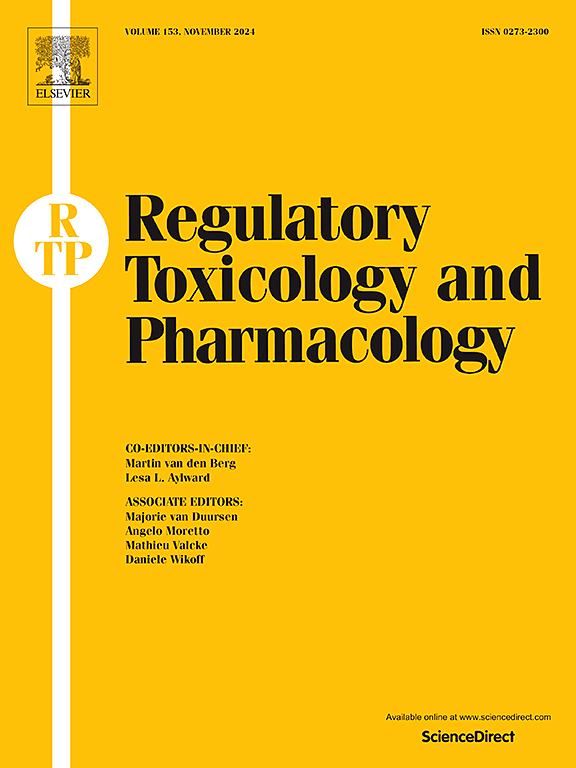Colemanite和生物破坏:行为,神经学和生理学的发现
IF 3
4区 医学
Q1 MEDICINE, LEGAL
引用次数: 0
摘要
Colemanite (COL)是一种含硼矿物,已显示出潜在的治疗应用,特别是在药物输送和骨骼健康领域。然而,尽管其具有良好的生物活性特性,但缺乏关于其安全性的综合毒理学数据,特别是关于其潜在医疗用途的数据。以往的研究主要集中在其工业应用上,对其生物效应的研究有限。这种知识上的差距促使了当前的研究,旨在通过行为学、血液学、生化、基因毒性和组织病理学分析来研究colemanite对大鼠的亚急性毒性。在7天的时间里,大鼠分别接受10、30和300 mg/kg的剂量治疗。行为评估,包括运动活动和升高的迷宫测试,表明探索行为增强,表明好奇心或活动增强,运动协调或焦虑样行为没有改变。血液学结果显示,红细胞压积、血红蛋白和红细胞计数呈剂量依赖性降低,而生化分析显示,高剂量时,天冬氨酸转氨酶、乳酸脱氢酶和胆固醇水平升高,提示肝毒性和脂质代谢紊乱。遗传毒性分析表明,在30和300 mg/kg时,微核形成增加,表明染色体不稳定可能与氧化应激有关。组织病理学评估显示,在最高剂量下,肝脏和脑组织出现轻度肝细胞变性和充血。重要的是,在10mg /kg剂量下没有观察到明显的毒性作用。这些发现强调了colemanite的剂量依赖性毒性,低剂量表现出良好的安全性。这项研究强调了剂量优化和进一步研究的必要性,以阐明colemanite毒理学效应的分子机制,包括其短期和长期暴露对各种器官的影响。此外,未来的研究应侧重于评估这些效应的人类相关性,以确保其安全有效的治疗应用。本文章由计算机程序翻译,如有差异,请以英文原文为准。
Colemanite and biological disruptions: Behavioral, neurological, and physiological findings
Colemanite (COL), a boron-containing mineral, has shown potential therapeutic applications, particularly in the fields of drug delivery and bone health. However, despite its promising bioactive properties, there is a lack of comprehensive toxicological data on its safety, especially regarding its potential medical use. Previous studies have primarily focused on its industrial applications, with limited investigation into its biological effects. This gap in knowledge prompted the current study, which aimed to investigate the subacute toxicity of colemanite in rats using behavioral, hematological, biochemical, genotoxic, and histopathological analyses. Over a 7-day period, rats were treated with doses of 10, 30, and 300 mg/kg. Behavioral assessments, including locomotor activity and elevated plus maze tests, indicated enhanced exploratory behaviors, indicating heightened curiosity or activity and no alterations in motor coordination or anxiety-like behaviors. Hematological findings revealed dose-dependent reductions in hematocrit, hemoglobin, and red blood cell counts, while biochemical analyses showed elevated aspartate aminotransferase, lactate dehydrogenase, and cholesterol levels at higher doses, suggesting hepatotoxicity and lipid metabolism disruption. Genotoxicity analysis demonstrated increased micronucleus formation at 30 and 300 mg/kg, indicative of chromosomal instability possibly linked to oxidative stress. Histopathological evaluations revealed mild hepatocyte degeneration and hyperemia in the liver and brain tissues at the highest dose. Importantly, no significant toxic effects were observed at the 10 mg/kg dose. These findings highlight the dose-dependent toxicity of colemanite, with low doses exhibiting a favorable safety profile. This study underscores the need for dose optimization and further research to elucidate the molecular mechanisms underlying colemanite's toxicological effects, including its impact on various organs over both short-term and long-term exposures. Additionally, future studies should focus on assessing the human relevance of these effects to ensure its safe and effective therapeutic application.
求助全文
通过发布文献求助,成功后即可免费获取论文全文。
去求助
来源期刊
CiteScore
6.70
自引率
8.80%
发文量
147
审稿时长
58 days
期刊介绍:
Regulatory Toxicology and Pharmacology publishes peer reviewed articles that involve the generation, evaluation, and interpretation of experimental animal and human data that are of direct importance and relevance for regulatory authorities with respect to toxicological and pharmacological regulations in society. All peer-reviewed articles that are published should be devoted to improve the protection of human health and environment. Reviews and discussions are welcomed that address legal and/or regulatory decisions with respect to risk assessment and management of toxicological and pharmacological compounds on a scientific basis. It addresses an international readership of scientists, risk assessors and managers, and other professionals active in the field of human and environmental health.
Types of peer-reviewed articles published:
-Original research articles of relevance for regulatory aspects covering aspects including, but not limited to:
1.Factors influencing human sensitivity
2.Exposure science related to risk assessment
3.Alternative toxicological test methods
4.Frameworks for evaluation and integration of data in regulatory evaluations
5.Harmonization across regulatory agencies
6.Read-across methods and evaluations
-Contemporary Reviews on policy related Research issues
-Letters to the Editor
-Guest Editorials (by Invitation)

 求助内容:
求助内容: 应助结果提醒方式:
应助结果提醒方式:


